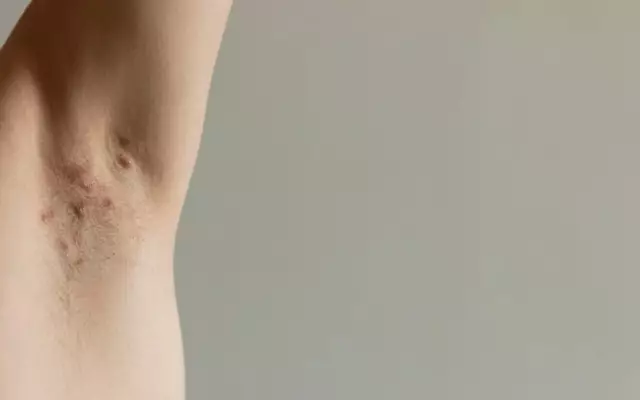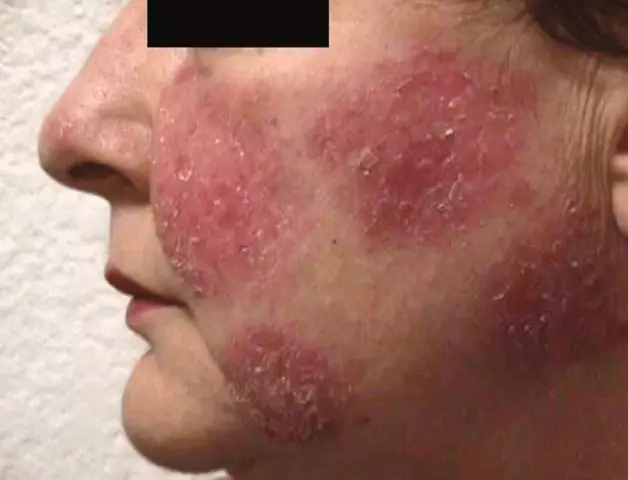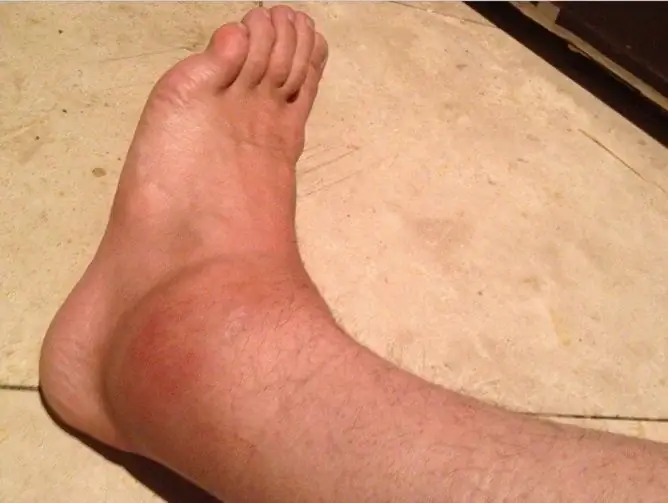- Author Rachel Wainwright [email protected].
- Public 2023-12-15 07:39.
- Last modified 2025-11-02 20:14.
Foot and mouth disease
General information about the disease
Foot and mouth disease is an infection that affects cattle, goats, pigs, camels, yaks, and deer. This viral disease is most common in countries with a predominantly agricultural population.
There are cases when other domestic animals also fell ill with foot and mouth disease: cats, dogs, horses, wild boars, even some species of birds and rodents (rats, gophers, mice). The causative agent of foot and mouth disease in infected animals is excreted together with milk, urine, feces, droppings, saliva, and the transmission of the disease occurs through direct contact in places where they are kept, in a pasture or watering place.

A person can become infected with foot and mouth disease only from animals, contacting them and consuming contaminated raw dairy products. When milk is pasteurized and boiled (the main methods of preventing foot and mouth disease), the causative agent of foot and mouth disease dies. The statistics of infection with this human infection is approximately the following: 65% of cases of FMD infection as a result of the consumption of raw milk, 1% - the use of other dairy products: yogurt, kefir, butter, whey made from raw milk, and, finally, 34% of infection with the virus FMD in humans occurred as a result of contact with sick animals. In the latter case, the carriers of the disease can be litter, drinkers, feed, water, manure, even the clothes of farm workers. It was also established that the wool of an infected animal is contagious for at least another month.
Cow, goat, camel milk are contagious even before the appearance of external signs of foot and mouth disease (ulcers on the mucous membrane), and remain so for another 12 days. At the same time, a quarantine is established, during which special attention is paid to the prevention of foot and mouth disease.
The human foot and mouth disease virus parasitizes on the mucous membrane of the nose, mouth, nails and between the fingers.
The clinical picture and symptoms of foot and mouth disease
Foot and mouth disease in humans is introduced into the mucous membrane of the mouth and (or) upper respiratory tract. In these places, bubbles appear, which collapse after the incubation period (from three to eight days), as a result of which the FMD virus enters the bloodstream. At this stage, secondary eruptions are formed on the mucous lips, nose, throat, mouth, cheeks, tongue.
This is followed by the septic stage of foot and mouth disease, which is characterized by an increased temperature (up to 40 °) and the appearance of bubbles on the skin (between the fingers and around the nails). From the blood vessels, the foot and mouth disease virus enters the internal organs and is excreted in feces, urine, saliva, bile.
The general condition of a patient with foot and mouth disease at the onset of the disease is severe - fever, weakness, chills, low blood pressure, a headache and an increased heart rate. All this happens in the first two days of illness, and the symptoms of foot and mouth disease are most pronounced and painful in the first day: a person has painful mucous membranes of the nose, tongue, mouth, he can feel a burning sensation in his mouth, experience muscle and lumbar pain. There is also profuse salivation, the mucous membranes of the cheeks, tongue, lips, arches and soft palate swell and turn red. There are also known cases when a patient, among the usual symptoms of foot and mouth disease, had a slight indigestion, cramps during urination.
At the initial stage of the disease, rashes appear on the mucous membranes of the mouth, nose, throat, cheeks, tongue of the patient with foot and mouth disease and last for an average of a week, after which, after one or two days, small wounds form in place of the bubbles, gradually merging into one lesion. Especially often, ulcers appear on the patient's tongue, as a result of which it is difficult for him to swallow and talk. Lips also swell, they also become covered with wounds and crusts.
After the appearance of such symptoms of foot and mouth disease as secondary rashes (on the skin of the hands and around the nails), another three to five days pass, and the patient's temperature begins to drop, reaches normal, and he begins to recover. The recovery period usually lasts no more than 15 days. After suffering foot and mouth disease, a person develops immunity to this disease.
FMD treatment
A patient with foot and mouth disease must be hospitalized for at least two weeks. Bed rest is especially important in the initial acute course of the disease. A patient with foot and mouth disease is prescribed a sparing diet with plenty of drinking and feeding several times a day in small portions of semi-liquid or liquid food, which is easily digested. There are also frequent cases of feeding through a tube. Before a meal, a patient with foot and mouth disease is given anesthesin (0.1 g).

FMD treatment is carried out with the help of antiviral drugs, which are prescribed from the very first days of the disease. These are local washing with 1% potassium permanganate, hydrogen peroxide or rivanol solution, and the application of ointments, for example, oxolinic, florenal, tebrofen, rhyodoxole, interferon.
For more intensive healing of ulcers, ultraviolet irradiation, aerosols "Livian", "Vinisol", "Panthenol" can be used.
With a particularly severe course of foot and mouth disease in humans, pain relievers, antihistamines, cardiovascular drugs, vitamins are prescribed, and detoxification measures are taken.
During the entire treatment of foot and mouth disease, special attention is paid to the hygiene of the patient's oral cavity.
Prevention of foot and mouth disease
Prevention of foot and mouth disease consists in strict adherence to sanitary measures and personal safety measures when caring for infected animals. It is imperative to boil, pasteurize milk brought from disadvantaged areas prone to foot and mouth disease epidemics. You can not use raw milk, dairy products, meat from an unknown, unverified manufacturer, purchased on spontaneous markets.
According to many doctors, there is no better prevention of foot and mouth disease than educating agricultural workers and the population, the publication of statistics on foot and mouth disease due to violation of quarantine and basic sanitary rules.
YouTube video related to the article:
The information is generalized and provided for informational purposes only. At the first sign of illness, see your doctor. Self-medication is hazardous to health!






